Donnie Madia is what you might call a particular person. To use a culinary term-after all, he is a restaurateur-Madia likes his world mise en place. A place for everything, and everything in its place.
At his two Randolph Street restaurants, Blackbird and Avec, that philosophy manifests itself through unfussy food, precise service, and austere, somewhat abstract interiors. Sparely modern, their looks are defined by subtraction rather than addition. Their walls are art-free, and the predominant shape is the rectangle.
Since Madia draws little or no line between his personal life and his professional life ("I work all the time," he says), it’s no wonder that his West Town loft is nearly as minimalist as his restaurants.
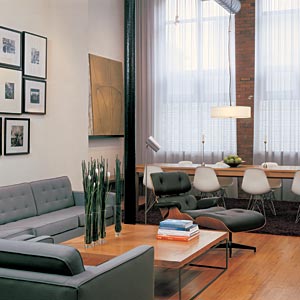 |
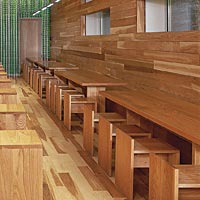 |
| Madia, a fan of the communal dining tables at Avec (right), jumped at the chance to buy this oak dining table, designed by the German firm e15, from SushiSamba Rio. | |
|
Photography: loft Nathan Kirkman; Styling Donnie Madia; Avec Doug Fogelson/DRFP
|
|
There, too, the rectangle dominates. "I like a grid," says Madia. Small objects are kept to a minimum-books, yes, family photos and houseplants, no. The matte finishes and clean lines of the furniture, from a custom-made walnut wardrobe in the bedroom to a Modernist credenza in the hallway, give Madia’s home much the same feel as his hip dining establishments.
That’s not to say it looks impersonal or retail-bland. Touches of color-a pair of orange chairs here, a muted teal painting there-and textural details such as wool shag area rugs make the 1,400-square-foot space lively and inviting.
"It feels like a home," says Michael Koehler, a Chicago furniture and cabinet designer who worked with Madia to design key pieces of furniture, including the walnut wardrobe and dramatic counters in the kitchen and bathroom. "The wools and walnut and the big galley kitchen-they’re what make it feel like home."
So does Madia’s collection of mid-century and custom-designed furniture and contemporary art and photography, much of which he bought or commissioned from local artists. "It’s like a gallery of furniture and art," he says of the loft.
Madia honed his design sensibility while working with New York architect Thomas Schlesser on the design of both Blackbird and Avec. "I learned simplicity from Thomas," he says. "You don’t have to indulge and overdesign."
Continuity is also key: all the pieces in the loft, whether they were made 50 years ago or ten years ago, are similarly sleek, spare-and rectangular. "They all have the same design aspect," Madia says.
He bought the loft (in a 1910 building that once housed a peanut business) in 1999, and began remodeling in earnest in 2000. He designed it himself, using Koehler, who also worked on Avec and Blackbird, as a collaborator. His first concern was ridding the space of the low-quality finishes in the bathroom and kitchen.
In the kitchen, Madia removed the 48-inch plywood island that the developers had installed but kept its black granite top, as well as the black appliances. "I didn’t feel like running out and buying stainless steel," he explains. He used the granite for the countertop area between the sink and the stove.
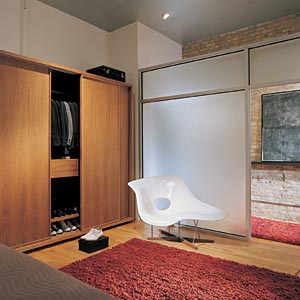 |
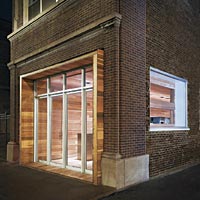 |
| Frosted glass panels with aluminum framing separate Madia’s bedroom from the hallway; he was inspired by the glass entrance (right) at Avec. The wall was Madia’s first design element; everything else in his condo sprang from it, he says. | |
|
Photography: loft Nathan Kirkman; Styling Donnie Madia; Avec Doug Fogelson/DRFP
|
|
He replaced the island with a 16-foot-long counter/table, designed with Koehler. A slab of matte black Corian that appears to float above a stainless steel frame, this piece extends from the entryway into the kitchen. One end is used as a desk. The middle has shelves underneath for pots and pans. The other end, equipped with two shortened Blackbird bar stools, serves as a kitchen table. A slim fluorescent tube hangs above the table, echoing the series of tubes over the communal tables at Avec.
The counter divides the kitchen from the living/dining area, the main repository for Madia’s art and furniture. A tall tower of white-oak shelves, his first custom-made piece of furniture, holds oversize art, fashion, and architecture books. Two Florence Knoll chairs, purchased from an office-furniture salvage company, and a Knoll sofa are upholstered in the same gray wool as the furniture in Blackbird’s private dining room. Hanging above the sofa is a grouping of black-and-white jazz and fashion photos, framed in both black and glossy brown, by Horst, Richard Avedon, William Klein, and other well-known photographers.
The photographs are the only pieces of art that actually hang from the loft’s walls. Madia prefers to display on shelves, calling the choice "a clean application to view artwork." A John Dunn diptych in dark teal and sage green perches on a shelf in the dining area, while a shelf on the opposite wall holds a black-and-white canvas by Chicago artist Wesley Kimler. A shelf above the fireplace is home to an orange-splashed silk-screen print of Queen Elizabeth I by another local artist, Janet Hamilton.
The Dunn and Kimler works flank a long, rectangular dining table, which Madia calls "another one of my deals." Before opening Avec, Madia had discovered the table, made of European oak, at the German design firm e15. However, even with a 20 percent discount, the price was prohibitive.
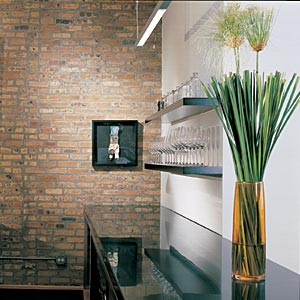 |
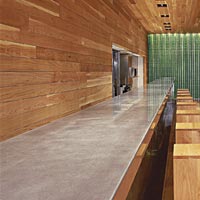 |
| Elongated rectangles abound: a steel-topped bar at Avec (right) is echoed, in Madia’s kitchen, by a 16-foot slab of Corian on a stainless steel frame. The counter runs from the hallway to the kitchen; at one end it serves as a desk, and at the other, a kitchen table. | |
|
Photography: loft Nathan Kirkman; Styling Donnie Madia; Avec Doug Fogelson/DRFP
|
|
When the restaurant SushiSamba Rio opened in 2003, the owners installed two e15 tables in its communal dining area. As luck would have it, "they couldn’t get anyone to sit there," Madia says. "So I bought one."
He paired it with molded plastic Eames "Eiffel Tower" chairs, part of what he calls his "evolving chair fetish." The collection includes an Eames swivel desk chair, a Hans Wegner ash chair with cream leather upholstery, a 1950s slipper chair, and, in the bedroom, a white molded fiberglass chaise lounge that Charles and Ray Eames designed in 1948 for a competition. The chaise was a gift from Sue and Al Ravitz, friends of Madia’s and frequent Blackbird patrons. The Ravitzes also gave him the John Dunn paintings ("I fell in love with them after having them for a year," Madia says).
By his own admission, he doesn’t spend much time at home. "I sleep here," he says. When Madia entertains, guests tend to hang around the kitchen counter and remark on the walnut wardrobe-but few, if any, mention similarities between where their host works and where he lives.
"What they notice," he says, "is that it’s a pretty nice space."
Florence Knoll
Florence Knoll of Knoll Associates, a prominent commercial-furniture design company, created most of her best-known furniture from the late 1940s to the early 1960s. Characterized by clean, sleek design, Knoll’s pieces are in high demand today for use in residential interiors.
Knoll, nee Florence Schust, studied architecture with Mies Van Der Rohe in Chicago; Mies inspired Knoll to look at furniture as an architect would, says Rebecca Dalvesco, assistant professor of architectural and design history, theory, and criticism at the School of the Art Institute of Chicago. Mies also prompted Knoll to view interiors as a whole: she designed pieces for a room after planning the space, rather than shoehorning in existing furniture. Interiors "became a total work of art for her," Dalvesco says.
Even Knoll’s earlier pieces retain their classic appeal. "The pieces fit in well because of their basic, straightforward shape," says furniture designer Michael Koehler. Her furniture is comfortable, too, which is why it works as well in residences as it did in offices.
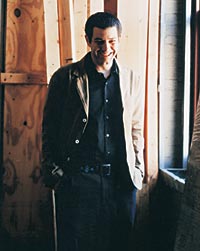 |
Michael Koehler
In Donnie Madia’s loft, it’s hard to tell what’s a mid-century classic and what’s a Michael Koehler original. That’s because Koehler, owner of Chicago-based Koehler Design Build (www.koehlerdesignbuild.com; 312-961-6914), subscribes to the same clean, architectural school of design as Charles and Ray Eames, Florence Knoll, and the other mid-century modernist design giants. (For the record, Koehler designed the wardrobe at right and the cocktail table shown on the previous spread).
Koehler, 33, grew up near Milwaukee. After graduating from the architecture program at the University of Wisconsin-Milwaukee in 1997, he began working for Big Blue Industrial, a Milwaukee-based salvage company, where he first started designing furniture. In 1999 he moved to Chicago to work for designer Holly Hunt. Koehler started his own company in 2000.
Koehler draws inspiration from all over the place-"a high-end piece of architecture, a street corner detail," he says. "A lot has to do with proportion and materiality." While exotic woods are all the rage, Koehler prefers simpler material: "Walnut is as beautiful as anything," he says. For Avec, he used cedar for the enveloping interior.


